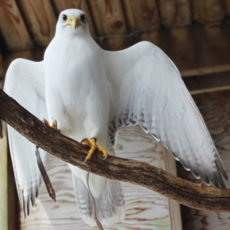Announcements


Among the many facets of caring for farm animals and wildlife at Green Chimneys is animal enrichment. The term is often misunderstood as devising ways to keep animals “busy.” In true practice, however, animal enrichment allows experts to assess each species’ environment and activities to consider what elements will best support natural behaviors for the good of each being.
“Animal enrichment is an important and fun topic. Those of us who work with animals in any area can continuously assess how we do what we do and if we can make improvements to each animal’s well-being,” explains Michael Kaufmann, director of both the Farm & Wildlife Center and The Sam and Myra Ross Institute at Green Chimneys. “The behavioral profile of each animal, their expected social grouping, and their natural habitat, give us strong clues as to what makes them thrive.”
An example would be a sheep living in a herd in a pasture. His life is enhanced simply by being part of a herd in a natural setting — grazing, walking, occasionally moving into the barn, etc. Adding a ball to the pasture is meaningless. For bigger animals living in a compatible social group, just being able to graze and move about freely in a larger area, is appropriate enrichment.
For animals that live in cages such as a lizard, guinea pig or even our birds of prey, one way we can contribute to their well-being is with exhibit design. Size of habitat, quality or usefulness of the space, the variety of substrates, levels, and complexities encourage important natural behaviors such as climbing, flying, hiding, body care, bathing and playing.
A student and a staff member work together on building a cardboard bunny castle. This activity may be a valuable exercise in helping students build empathy. What kind of space do bunnies need? What do they like to do? Activities like this one have another purpose: they aid in enhancing the lives of our animals. For species like rabbits, a special habitat fulfills an innate desire to explore, dig and chew but for another animal, a cardboard construct or other objects are less relevant and may not bring value to their life.
We partner with horses, llamas, camels, dogs, and cows, to name a few, for animal-assisted activities with children so investing in their basic socialization and relationship-building can also enrich their quality of life. When a new animal joins our farm, a team of experts considers where the animal came from, the role it may play with our children, and what we need to provide to ensure its well-being. This is a process that will be revisited time and again throughout an animal’s life at Green Chimneys.
Explore best practices in leading nature-based education programs

Crowned the best for falconry in medieval times, gyrfalcons were once reserved for kings. As the largest falcon in the world, with exquisite plumage ranging from bright white to deep charcoal, gyrs are revered for their powerful skill of flight. Their long wings make hunting waterfowl from 3,000-feet-high a feasible and fantastical feat. This falcon was flown in the sport of falconry for several years.